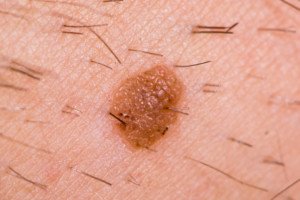
Relax, do not panic if you discover what appears to be a rapidly growing mole on your face, leg, stomach, arm or any other area of your skin.
I asked Sharyn Laughlin, MD, if a fast growing and new mole is necessarily a melanoma.
“No,” responds Dr. Laughlin, a dermatologist and developer of the DermaEnvy Skincare ™ line of sun protection products and medical director of Laserderm, a pioneering laser skin surgery clinic in Ottawa, Ontario, Canada.
Dr. Laughlin explains, “In a child undergoing a growth spurt, the mole may just be growing with the child in proportion.”
So if you’ve noticed a new mole on your child that’s rapidly growing, do not panic.
But what about in adults?
“For adults, moles can appear suddenly after sun exposure and especially sunburn,” says Dr. Laughlin.
“We estimate that 60 percent of moles are related to UV exposure.
“Hormonal changes can also bring about a quickly changing and/or growing mole.”
Mole Impersonators
“Seborrheic keratoses are another example in middle aged people that can grow quickly and look especially worrisome,” says Dr. Laughlin.

Shutterstock/IanRedding
Quite frankly, a seborrheic keratosis can strongly resemble a melanoma.
It can also look very much like a typical common mole.
These benign skin barnacles commonly occur in people over age 40 and will NEVER turn into cancer.
But this doesn’t mean that, by sheer chance, a melanoma can’t start growing right in the same skin real estate as the barnacle, creating the illusion that the barnacle itself has turned malignant.
This is why it’s a good idea to include your seborrheic keratoses in your monthly skin exams, but do not freak if you notice rapid changes in one.
In fact, very rapid changes in appearance that you can detect from day to day point heavily to benign changes in the barnacle rather than to malignant changes in the skin.
Another harmless mole imposter is the lentigo (below). These appear in adults and are usually the result of sun exposure.

And yet another good mole impersonator is a so-called hemorrhage.
This is what dermatologists call a tiny collection of dried blood on the surface of the skin – the result of some kind of minor trauma such as scratching.
These tiny scabs can appear almost black and seemingly arise out of nowhere, sticking around for weeks since they’re embedded into the skin.
They’ll eventually drop off or be rubbed off by clothing or simply swiping fingers over the area.
No list of mole imposters is complete without mentioning the inflamed hair follicle.
Unless you’re able to get a close-up inspection, these can look like a rapidly growing mole.
The Three Month Rule
“We apply the rule of three months — many things can come and go within a span of three months,” says Dr. Laughlin.
“If something continues to change in whatever way for longer than three months, then some intervention is required, starting with an expert examination by your dermatologist, who will decide if a biopsy is indicated.”
In practice for 30+ years, Dr. Laughlin has been lead or co-investigator in many research trials and an innovator in developing new laser technology. dermaenvy.com.
 Lorra Garrick has been covering medical, fitness and cybersecurity topics for many years, having written thousands of articles for print magazines and websites, including as a ghostwriter. She’s also a former ACE-certified personal trainer.
Lorra Garrick has been covering medical, fitness and cybersecurity topics for many years, having written thousands of articles for print magazines and websites, including as a ghostwriter. She’s also a former ACE-certified personal trainer.
.










































